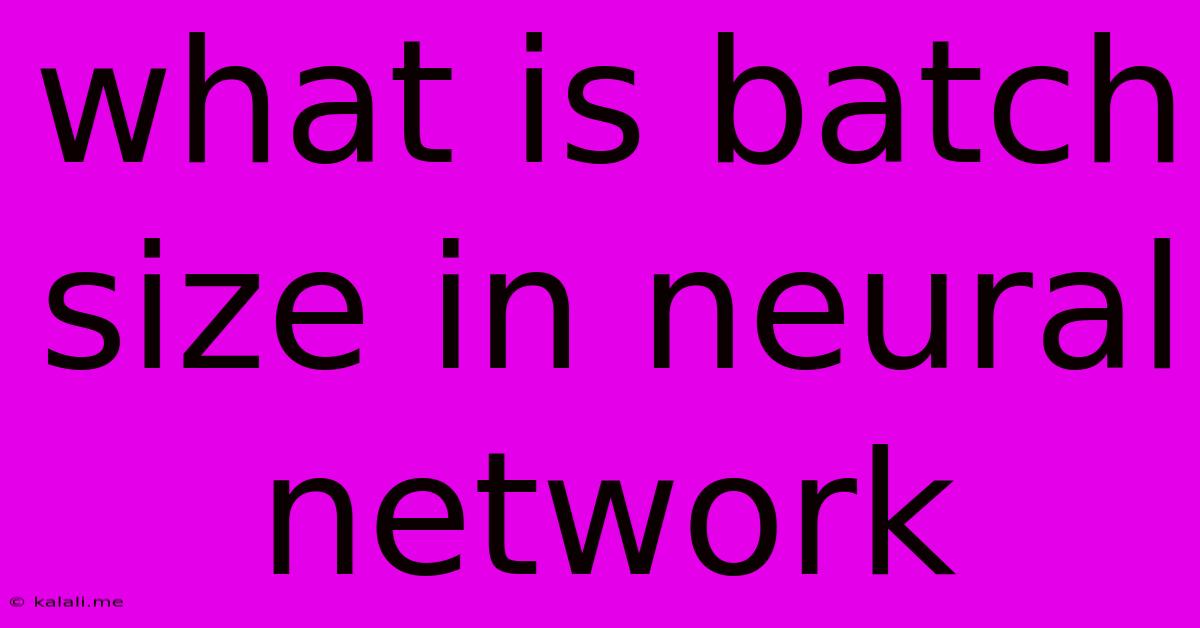What Is Batch Size In Neural Network
Kalali
Jun 02, 2025 · 4 min read

Table of Contents
What is Batch Size in Neural Networks? A Deep Dive into Optimization
Understanding batch size is crucial for anyone working with neural networks. It significantly impacts training speed, memory usage, and ultimately, the model's performance. This article will delve into the concept of batch size, exploring its role in the optimization process and guiding you towards choosing the optimal value for your specific needs. Choosing the right batch size can mean the difference between a quickly trained, accurate model and a slow, resource-intensive process.
What is Batch Size?
In the context of neural network training, the batch size refers to the number of training examples used in one iteration of gradient descent. The entire training dataset is divided into multiple batches. During each iteration, the model processes one batch, calculates the loss, and updates its weights accordingly. This iterative process continues until the model converges or reaches a predefined number of epochs.
Think of it like this: instead of updating the model's weights after considering every single data point (which would be a batch size of 1 – known as stochastic gradient descent), you process a group of examples simultaneously. This approach offers a balance between computational efficiency and accurate gradient estimation.
Different Batch Sizes: A Comparison
There are three main types of batch sizes, each with its own advantages and disadvantages:
-
Batch Gradient Descent (Batch Size = Entire Dataset): In this approach, the entire dataset is used to compute the gradient in each iteration. This results in a very accurate gradient calculation, leading to stable convergence. However, it's computationally expensive, especially for large datasets, and requires significant memory. It's often impractical for large-scale machine learning problems.
-
Stochastic Gradient Descent (Batch Size = 1): Here, each training example is considered as a separate batch. This method introduces a high level of noise in the gradient estimation, leading to noisy updates and potentially erratic convergence. While computationally less intensive per iteration, the overall training time can be longer due to the noise and increased number of iterations.
-
Mini-Batch Gradient Descent (Batch Size > 1 and < Entire Dataset): This is the most commonly used approach. It strikes a balance between the accuracy of batch gradient descent and the computational efficiency of stochastic gradient descent. The chosen batch size is a hyperparameter that influences the model's training process. A typical mini-batch size ranges from 32 to 512, although this can vary significantly depending on the dataset and model complexity.
How Batch Size Impacts Training
The choice of batch size impacts several aspects of neural network training:
-
Training Speed: Larger batch sizes generally lead to faster training per iteration because vectorized operations are more efficient. However, more iterations may be required for convergence. Smaller batch sizes may take longer per iteration but can lead to faster convergence overall.
-
Memory Usage: Larger batch sizes require more memory to store the batch and compute gradients. Smaller batch sizes have lower memory requirements.
-
Generalization Performance: Smaller batch sizes tend to introduce more noise into the gradient updates, leading to more exploration of the parameter space. This can sometimes lead to better generalization and prevent the model from getting stuck in local minima. Larger batch sizes can lead to faster convergence but might result in overfitting if the model converges to a sharp minimum.
-
Computational Resources: The optimal batch size is highly dependent on the available computational resources (GPU memory, CPU cores). Larger batch sizes might require more powerful hardware.
Choosing the Right Batch Size
Selecting the appropriate batch size is crucial. There is no one-size-fits-all answer; it's an empirical process involving experimentation. Factors to consider include:
-
Dataset Size: For smaller datasets, a smaller batch size or even stochastic gradient descent might be appropriate. For larger datasets, mini-batch gradient descent is preferred.
-
Model Complexity: More complex models might benefit from larger batch sizes for computational efficiency.
-
Available Computational Resources: The hardware constraints will limit the maximum possible batch size.
-
Convergence Behavior: Monitoring the training loss and validation accuracy can help in determining if the chosen batch size is appropriate. Experiment with different batch sizes to find the optimal balance between training speed and generalization performance.
Conclusion
Batch size is a critical hyperparameter in neural network training. Understanding its impact on training speed, memory usage, and model performance is essential for building effective machine learning models. Experimentation and careful consideration of the factors discussed above are key to finding the optimal batch size for your specific task. Remember that the "best" batch size is often discovered through experimentation rather than through a theoretical calculation.
Latest Posts
Latest Posts
-
Distance From Wall For Toilet Rough In
Jun 04, 2025
-
What Is Built In J Channel For Windows
Jun 04, 2025
-
Professional Term For Dos And Don Ts
Jun 04, 2025
-
How Old Was Samuel When God Called Him
Jun 04, 2025
-
How To Mount Dishwasher To Granite
Jun 04, 2025
Related Post
Thank you for visiting our website which covers about What Is Batch Size In Neural Network . We hope the information provided has been useful to you. Feel free to contact us if you have any questions or need further assistance. See you next time and don't miss to bookmark.